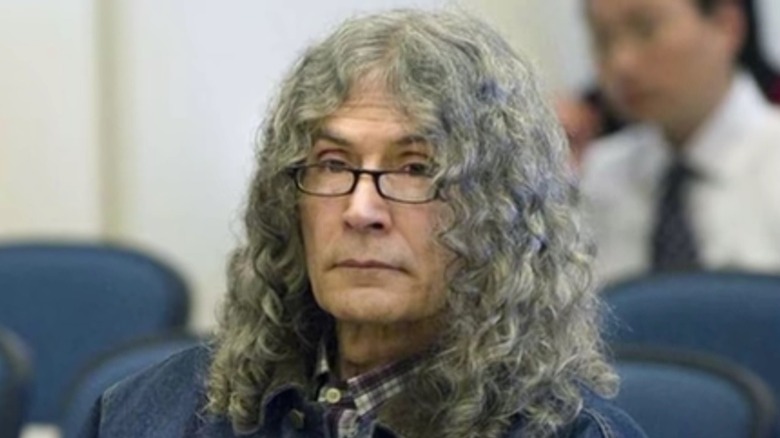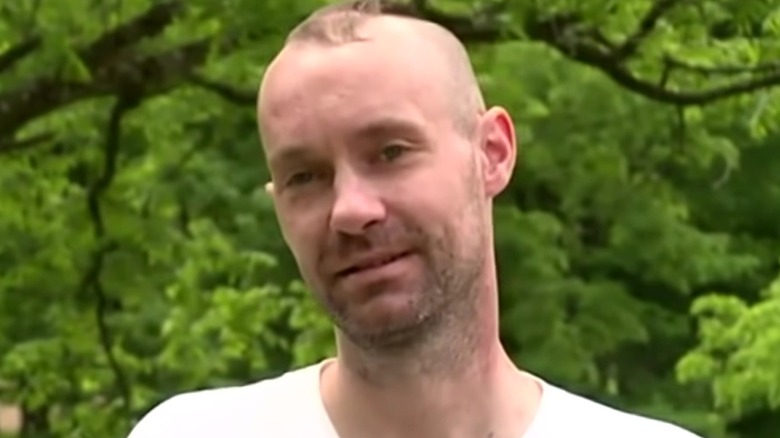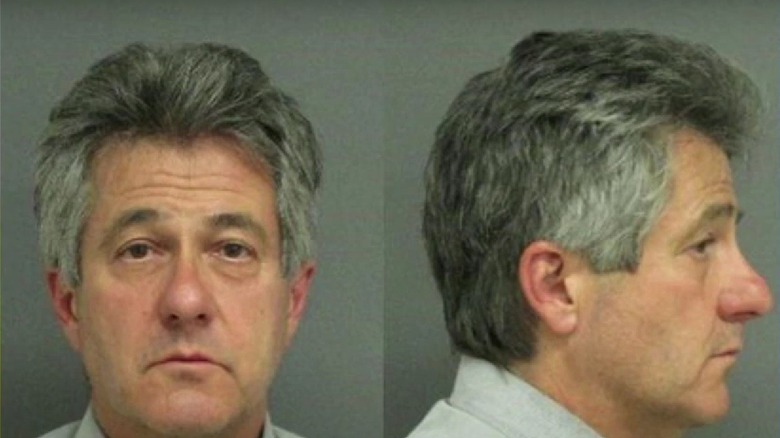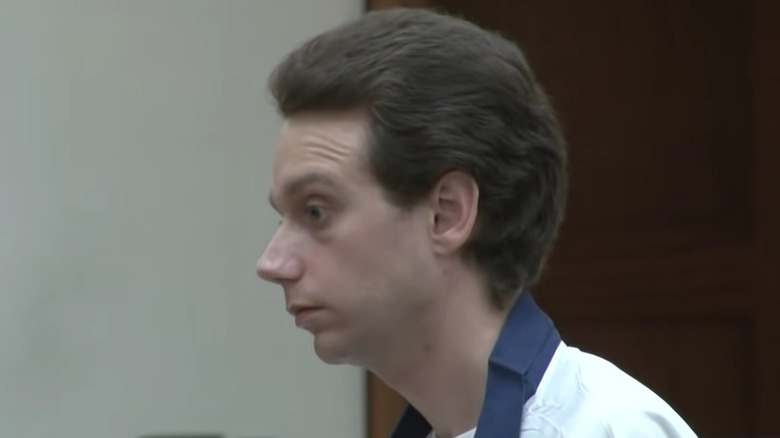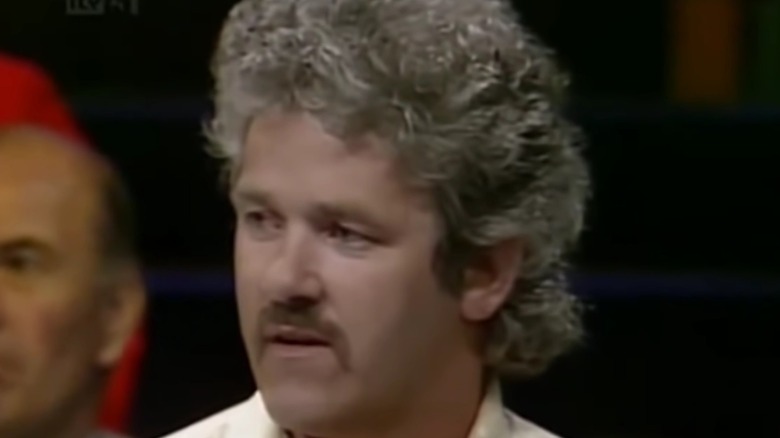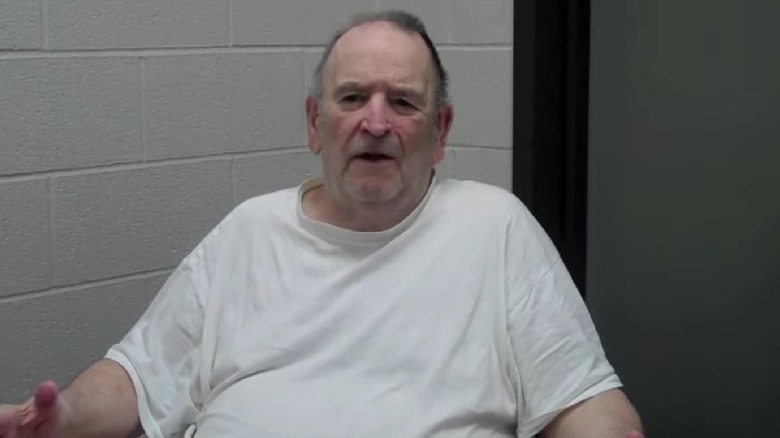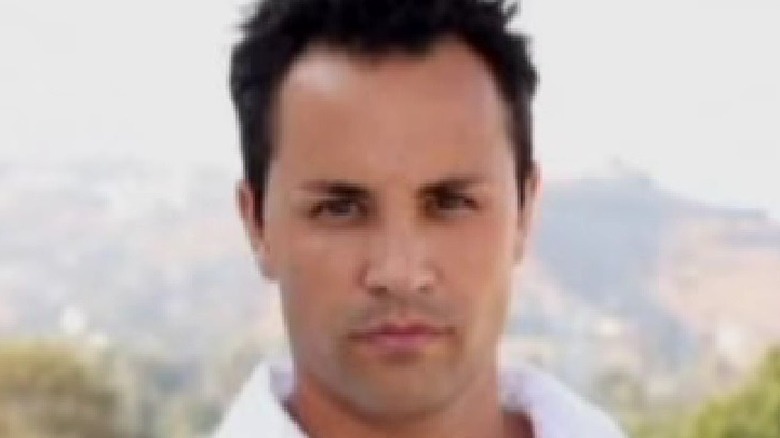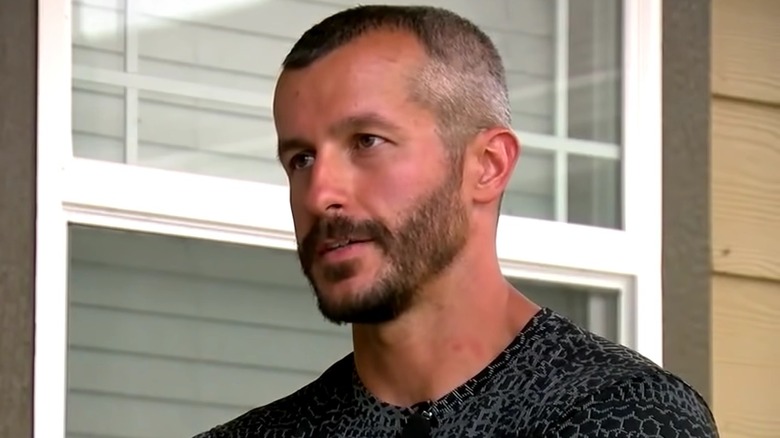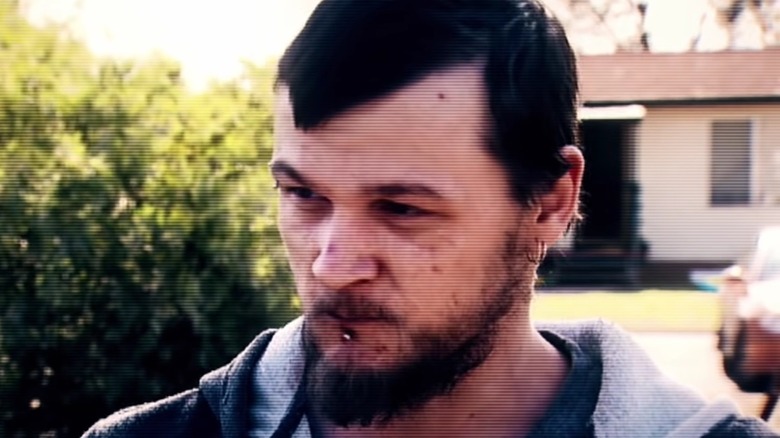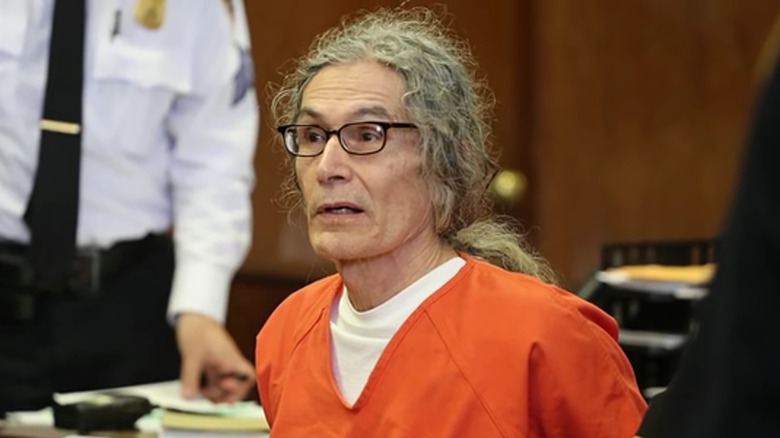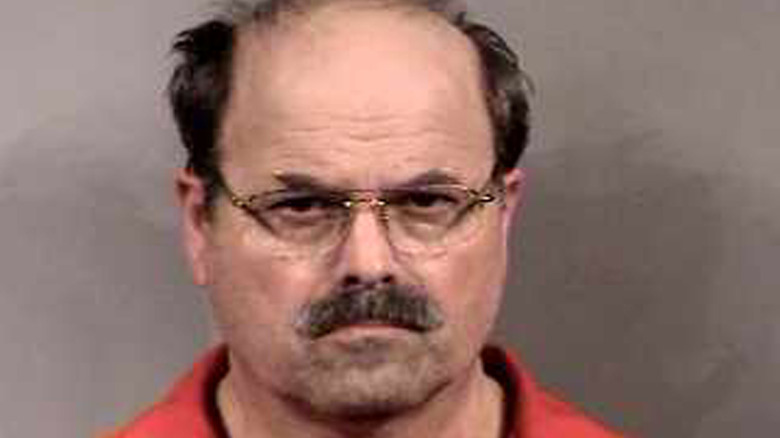Killers Who Were On TV Before Being Caught
As consumers of entertainment, many of us tend to have a morbid fascination with those who are capable of committing murder. From movies, binge-watching television series, and listening to podcasts about their exploits, there's usually (hopefully) one thought in mind: How can they do it? How can any person bypass their conscience, their innate humanity, to take the life of another? Or, in the case of serial killers both real and fictional that have come to permeate popular culture, many others?
It's a question that any criminologist will tell you defies any easy answers, but that doesn't stop us from asking. As such, it's pretty common to see heartless killers all over our TV screens ... being portrayed by actors. But what about when the real thing gets their moment of infamy — and not for getting caught and convicted. Whether they were stopped by chance for interviews with news crews, featured on reality TV programs, or picked to be contestants on game shows, these are actual murderers that appeared on television before being apprehended for their crimes.
Timothy Bliefnick
When the Bliefnicks of Quincy, Illinois, appeared on the long-running game show "Family Feud" in January 2020, they presented themselves as quite the typical American family. Bow-tied, outwardly goofy Dad Timothy Bliefnick helped the family to victory with a cheeky — if somewhat messed-up — answer to one question: "What was the biggest mistake you made at your wedding?" His answer: "Saying 'I do,'" which elicited a predictably shocked response from host Steve Harvey (via Inside Edition). Timothy quickly offered the caveat that he loved his wife, joking, "I'm going to get in trouble for that" — and he would indeed get into big trouble after the broadcast, for a crime that made his silly response seem a heck of a lot like ominous foreshadowing.
Timothy was indicted in March 2023 in the slaying of his wife Rebecca Bliefnick, who had been shot several times in her home. The pair were estranged and had recently filed restraining orders against each other. He pled not guilty at his arraignment but was convicted two months later on charges of first-degree murder and home invasion. He is awaiting sentencing, set for August 11, and could face up to 45 years in prison, with the prosecution also likely arguing for a life sentence.
Matthew Haverly
When a woman's body was found dumped in a creek in quiet, rural Bradford County, Pennsylvania, it wasn't exactly the kind of thing residents of the area were accustomed to. Local man Matthew Haverly, who was interviewed by news station WNEP, said as much before segueing into a bizarre theory of what might have occurred. "I think it was kind of a hit, and something happened," he said. "Something went bad, and this is like a rural area, so they just wanted to plant the body somewhere else besides wherever the hell they were from." He didn't go so far as to speculate as to who "they" might be — perhaps because he knew that the as-yet unidentified victim was his mother, and that he himself was her killer.
Under questioning by the police, Matthew admitted that he and his 60-year-old mother, Patricia Haverly, had gotten into a fight the day before but he had blacked out after. Police allege he hit her in the head before wrapping her body in a tarp and dumping it in the creek. While it seemed an open-and-shut case, it was later reported that a forensic pathologist had been unable to definitively point to the head injury as Patricia Haverly's cause of death. Ultimately, Matthew Haverly pleaded guilty to involuntary manslaughter and other charges related to the crime and received a prison sentence of three to 14 years.
Paul Curry
Nuclear engineer Paul Curry was nothing if not a worldly man. Merry Seabold, the best friend of Curry's wife, Linda Kincade, would have occasion to describe him as a man who "knew a little bit about everything in life," and indeed, Curry had flexed his knowledge to become a two-time "Jeopardy!" champion. Unfortunately, Seabold offered this description for the Oxygen true-crime series "Charmed to Death" in an episode focused on how Curry had slowly poisoned Kincade to death with pure nicotine over the course of 15 months.
Kincade had been hospitalized several times during the pair's brief marriage with unexplained illnesses, and try as they might, doctors were unable to pinpoint the cause. In 1994, Kincade succumbed to her mystery illness, but with no proof of foul play, her death remained an enigma — until 2002, when investigator Yvonne Shull got hold of her file. Digging into Curry's past, she discovered that one of his two previous wives had reported symptoms very similar to Kincade's. A toxicology report, which was positive for nicotine despite the fact that Kincade was a non-smoker, was ... well, the smoking gun. Curry was arrested in 2010, and in 2014 — two decades after Kincade's death — he was found guilty of her murder and sentenced to life in prison.
Stephen McDaniel
In June 2011, a horrible fate befell 27-year-old Lauren Giddings, who had recently graduated from Mercer Law School in Macon, Georgia. Just days after the young woman went missing, police found her torso, and only her torso, in a dumpster outside a residence hall at the school. At the moment the grisly discovery was being divulged to the news media, a local television station was interviewing another recent Mercer grad, Giddings' neighbor, Stephen McDaniel. McDaniel was offering up info as to when she was last seen and what type of neighbor she was when the interviewer told him that police had found a body — a revelation that prompted the man to excuse himself to sit on the ground, staring into space, which was captured by the TV cameras.
Police quickly became interested in McDaniel, but a long, grueling night of interrogation failed to elicit a confession. As it turned out, though, further evidence uncovered by the cops while he sat in jail — which included a hacksaw used in Giddings' dismemberment — pointed them to McDaniels as their sole suspect. In 2014, he pleaded guilty to Giddings' murder, and he's currently serving a life sentence with possible parole.
John Cooper
It took an extraordinary amount of luck and happenstance to put serial killer John Cooper behind bars for murder. The Welshman served 16 years between 1998 and 2014 for armed robbery and burglary, but investigators had long sought to link him to two other crimes: the 1985 double murder of siblings Helen and Richard Thomas, who were shot to death in their home, and the 1989 killing of married couple Peter and Gwenda Dixon, who had been robbed and shot in broad daylight while on vacation in Pembrokeshire, Wales. With very little to connect Cooper to the crimes, he might have evaded punishment forever — if not for an appearance on a TV game show in between the two incidents.
In an interview with Wales Online, Detective Steve Wilkins explained that a police sketch made at the time of the Dixons' murder had not been matched up to any suspects at the time. But when Wilkins got hold of the case in 2005, he happened to hear through word-of-mouth that Cooper had appeared on the game show "Bullseye," a darts competition, in 1989. After reviewing footage of the appearance, he found that Cooper indeed closely resembled the police sketch, which led him to look more closely into Cooper as a potential suspect. Not long afterward, investigators recovered a pair of Cooper's shorts, which yielded a microscopic trace of blood — enough to make a DNA match for Peter Dixon. Cooper was tried and convicted of murder in 2011 and received a life sentence.
Edward Wayne Edwards
In a 1972 episode of the classic game show "To Tell the Truth," contestants were tasked with identifying the real Edward Wayne Edwards — an admitted con man and armed robber who, he said, had turned his back on his life of crime while imprisoned in a federal penitentiary. He had even written a book, titled "Metamorphosis of a Criminal," which detailed his story. As it turned out, though, Edwards had not reformed himself — indeed, he would eventually be convicted of crimes, which made those for which he had been jailed look positively pedestrian.
In a 2018 interview with People, Edwards' daughter April Balascio revealed that when she was a child, her father had been obsessed with crime and killers and had often moved them in the middle of the night for no apparent reason. As an adult in 2009, she began investigating cold murder cases in the areas where they had lived and found many that chillingly corresponded with her family's time there. She alerted authorities as to her suspicions over one case in particular, a double homicide in Wisconsin in 1980 — and just three weeks later, those same authorities called to let her know they had obtained DNA from Edwards, and it was a match to DNA lifted from the crime scene. Edwards later confessed to killing five people, including his own foster son, whom he murdered for an insurance payout. While awaiting execution for that crime, Edwards died in prison in 2011.
Ryan Jenkins
California real estate developer Ryan Jenkins appeared to have a lot going for him: a career, a gorgeous new wife, and a promising side job as a reality TV star. He had gotten hitched to his wife, Jasmine Fiore, just after wrapping filming on VH1's "Megan Wants a Millionaire," and he would often call her from the set of the third season of another of that network's "celebreality" series, "I Love Money." According to producer Mark Cronin, though (via Entertainment Weekly), those calls were not so much cutesy check-ins as they were jealous interrogations. "We were actually making a story of it on the show," Cronin said. "It was funny, until it wasn't funny at all."
In August 2009, shortly after filming completed on the series, Fiore's body was found dismembered, crammed into a suitcase, and discarded in a dumpster in Buena Park, California. It took police no time at all to focus their investigation on Jenkins, who promptly fled to Canada. On August 23, 2009 — just over a week after Fiore's body was found — he died by suicide in a hotel room in British Columbia. "Megan Wants a Millionaire," which was airing episodes at the time, was canceled, and the third season of "I Love Money" never made it to air; it, too, was canceled.
Chris Watts
On August 14, 2018, Colorado oil field worker Chris Watts gave an interview to a local television station to give an update on the police investigation into the disappearance of his pregnant wife, Shanann Watts, and two young daughters, whom he had reported missing the day before. His demeanor was calm, his statements matter-of-fact, as he expressed his hope for his family's safety — but by the next day, he would be in police custody, where he confessed to killing all three of them.
Their investigation had uncovered an extended recent separation and text messages indicating that the marriage was ending, and not happily; Shanann had, in fact, suggested that Chris might never see his kids again. Physical evidence, including Shanann's cell phone hidden between some couch cushions and her untouched purse, clued police in to the fact that Shanann had not gone anywhere voluntarily. Presented with their suspicions, it didn't take Chris long to crack. He had strangled his wife, smothered his children one after the other, and dumped them in the oil field where he worked. In November 2018, Watts was sentenced to three consecutive life sentences in prison, with no possibility for parole.
Margaret and Neil Archer
When 20-year-old Jody Meyers of Mannum, Australia, went missing in 2015, her fiance Neil Archer took part in an interview with the local television station pleading for her safe return with his mother, Margaret Archer, by his side. Meyers and Neil had a young son together, whose well-being Margaret invoked while tearfully imploring Meyers to return home. "Her son needs her," she said, between sobs; "He needs his Mom." It was a stunning performance, considering that at the time it was given, Margaret knew exactly where Meyers was: buried underneath freshly poured concrete in her shed, having been murdered by Neil.
Neil Archer had killed Meyers when he feared that her family was trying to drive them apart, and in addition to playing for the cameras, Margaret Archer had helped her son to cover up the crime in numerous ways — sending text messages to Meyers' family from her phone, disposing of said phone after that was done, and purchasing the concrete and tools (with Meyers' stolen bank card) used to conceal her body. In 2017, Neil Archer was convicted of murder and sentenced to at least 22 years in prison; for her role in the crime, Margaret Archer was sentenced in 2018 to six and-a-half years.
Gerard Baden-Clay
Gerard Baden-Clay of Queensland, Australia, choked back tears as he told local TV crews of his anxiety over the disappearance of his wife, Allison Baden-Clay, in 2012; at the time, she had been missing for a few days. "I'm trying to look after my children ... we've got three young girls, and we really trust that the police are doing everything they can to find my wife," he said. Indeed, they were: In 2014, investigators had been immediately, deeply suspicious of Gerard, due to inconsistencies in his story and uncharacteristically affectionate text messages that he'd sent his wife (he'd recently ended an affair, and the marriage was troubled). Also, he had ragged scratches down his right cheek, which he claimed he'd given himself shaving.
More scratches, all over his body, were uncovered during a doctor's examination, and 10 days after her disappearance Allison's body was found in a creek miles away from the family home. Largely on the strength of Baden-Clay's injuries, he was convicted of her murder in 2014. In 2015, the charge was downgraded to manslaughter, as a judge ruled that the jury had not been allowed to consider the possibility that Baden-Clay had accidentally killed his wife; the following year, the High Court found this scenario to be purely hypothetical and reinstated the murder conviction.
Rodney Alcala
In the '60s and '70s, before digital records, offender databases, and instantaneous background checks, it was much easier for convicted criminals to distance themselves from their sordid pasts. Take, for example, Rodney Alcala, who served 34 months in prison for sexually assaulting a 8-year-old girl in 1968. Despite having registered as a sex offender, Alcala was able to gain employment as a typesetter with the Los Angeles Times in 1977 — and in 1978, he appeared as a contestant on the classic game show "The Dating Game," where he was selected for a date with the lovely bachelorette.
That woman, Cheryl Bradshaw, eventually declined her date with Alcala, simply because he gave her bad vibes. Her intuition proved to be dead-on. By the time of his appearance on the show, Alcala had already committed several of the crimes he would later be convicted of — the murders of six women and an underage girl, between 1971 and 1979. Alcala, who would become infamous as the "Dating Game Killer," was arrested and charged for the murder of 12-year-old Robin Samsoe in 1980. His conviction and death sentence were overturned on a technicality; Alcala was re-convicted in 1986, only for that conviction to be similarly overturned in 2001. Finally, in 2003, DNA evidence proved to be Alcala's undoing. Investigators were able to tie him to a number of unsolved murders using DNA obtained from him in prison, and in 2010, he was sent to death row for the final time. He died while awaiting execution in 2021, and authorities ultimately estimated he may have been responsible for up to 130 murders.
Dennis Rader
During the time he served as a compliance officer in Park City, Kansas, Dennis Rader had occasion to be interviewed by local television station KSN about a series of incidents involving out-of-control dogs in the area. In the 2001 interview, he appeared authoritative and professional, and he was known to be a strict and by-the-book compliance officer. It has been speculated that his position satiated his deep need for control — because in the decade that he had been employed by Park City, Rader had not killed, and before then, he had killed many.
Rader was the infamous "BTK Killer," which stood for "Bind, Torture, Kill," which should tell you all you need to know about his methods. A few years after his TV appearance, he would begin taunting the press and the police with clues as to his identity, apparently for his own amusement — and it was these clues that diligent detectives used to single out Rader as a possible suspect. DNA evidence collected from Rader's daughter confirmed their suspicions, and in 2005, Rader was arrested and charged with 10 counts of first-degree murder. He pleaded guilty and was handed 10 consecutive life sentences.
